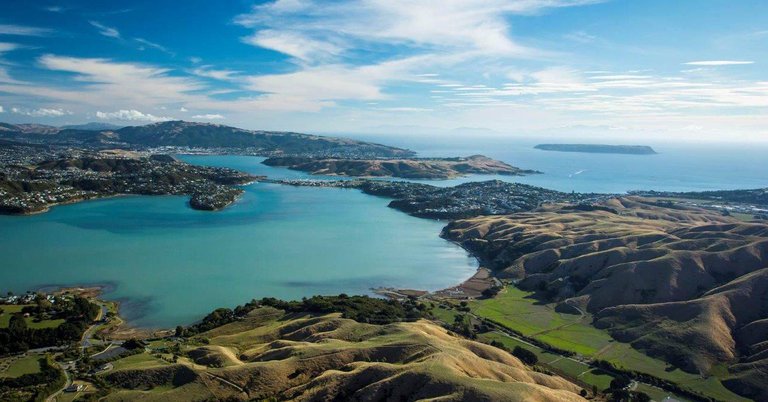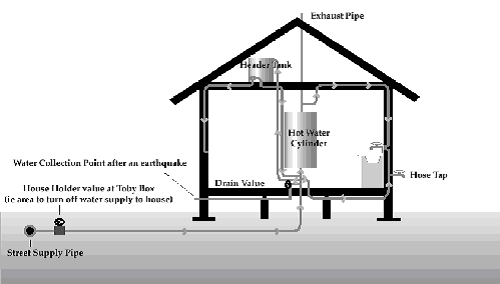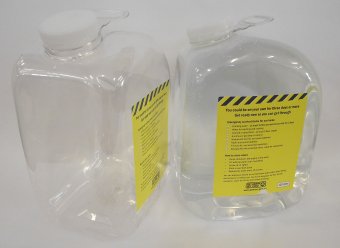

The water that comes out of your tap in Porirua comes from the Te Marua storage lakes north of Upper Hutt. It gets pumped up and over Haywards Hill before flowing to our reservoirs, and on down to you.
In a big event, like an earthquake, this network may be severely damaged. We’ll try to preserve the water in the reservoirs by shutting down the supply. This means that there will be no supply of water directly to your house or workplace, so you need to have some stored.
Store a minimum of 20 litres for each person in your household
Think about all the things you use water for on a day-to-day basis, and which one of these you would like to do after an emergency. Most people in the Wellington Region use 220L per day. As a general rule, you need:
👉 3L per person per day for a week is the minimum you need for drinking and food preparation.
👉 Up to 20L per person per day for a week will allow you to eat, drink, wash dishes and some clothes, as well as washing yourself.
Any more than this will allow you to do some of the things we take for granted on a daily basis.
Remember, once you run out of water in your home, you will either need to walk to collect more, and it could be a reasonable distance, or hope that it rains.
Save plastic soft drink or juice bottles.
Don’t use milk containers as it is practically impossible to remove the milk residue. You can also buy large emergency water containers from the council office, hardware stores and catering suppliers.
Replace the water every 12 months.
Since our tap water is chlorinated, it will stay clean for a long time. If you have used filtered water, water from an aquifer (like the one in Petone), or rainwater, you may have to check it more often - it doesn’t have the chlorine to keep it clean.
If you are uncertain about how clean the water is, treat or boil it before use.
👉 TOP TIP Storing some in the freezer means you can use the ice to cool food in the fridge in the event of a power cut, or put it in the chilly bin when you go out for a picnic, to keep things cold and have an ice-cold drink!
Your hot water cylinder and header tank can be a great source of clean water, so make sure your header tank in the ceiling is secured, and your hot water cylinder is strapped into place.
To save this water after a damaging event:

Toilet cistern (not the bowl!)
You can use the water from the cistern above the toilet, as long as you haven’t added chemicals to disinfect or make your toilet smell better. Obviously, don’t use the water from the toilet bowl. It’s bad enough that the dog tries to drink from it!
Swimming pools
You can use swimming pool water for cleaning purposes. Heat up a couple of pots and use it to do dishes, or wash clothes etc.
Streams or springs
There are quite a few natural sources of water around Porirua. Collect stream water from where it comes out of bush areas, as close to its source as possible. Boil all water from natural sources.
Do not collect drinking water from
Rain water
Collect rain water from your roof by disconnecting one of the downspouts and collecting from the roof guttering. Or you can use a plastic sheet or tarpaulin to collect rainwater.
Remember that water that is not clean may make you sick, or could even kill you. In a disaster, with little or no medical attention available, you need to remain as healthy as possible.
Drinking water that isn’t clean can make you very sick and even kill you. Treat any water that you are going to put in your mouth (including brushing your teeth), and the water you use to wash your hands.
Here are several ways you can make water safe to drink.
While this system isn’t the best way to make water safe, if you have no other options it is better than nothing. Once this system is up and running, remember to change the sand or dirt regularly.
Another filtering option is to invest in a water filter such as a Life Straw. These can be found in some camping shops or online.

Can be purchased and picked up only from the Customer Service Centre at 16 Cobham Court during normal office hours for $128.

Can be purchased and picked up only from the Customer Service Centre at 16 Cobham Court during normal office hours for $6.50.

This summer, Wellington, Porirua, Lower Hutt and Upper Hutt face the risk of tighter water restrictions and possible water shortages. While these councils, through Wellington Water, are doing what they can to fix leaks, we all need to play our part by following water restrictions, reducing our water use and having an emergency water supply.